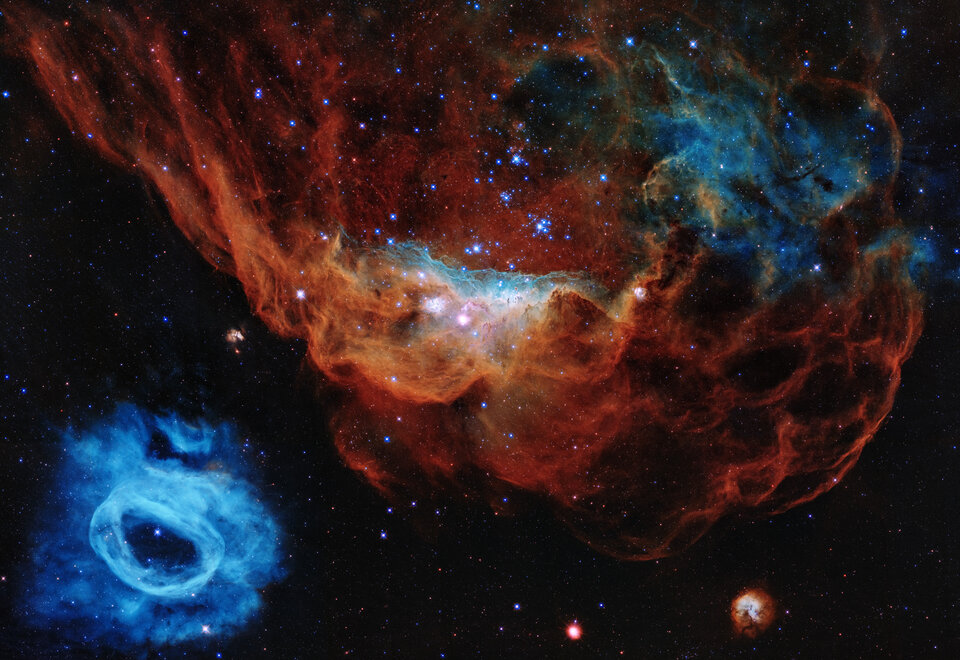Blog
This NASA/ESA Hubble Space Telescope image shows the massive galaxy cluster MACSJ 1206. Embedded within the cluster are the distorted images of distant background galaxies, seen as arcs and smeared features. These distortions are caused by the dark matter in the cluster, whose gravity bends and magnifies the light from faraway galaxies, an effect called gravitational lensing. This phenomenon allows astronomers to study remote galaxies that would otherwise be too faint to see. Overlaid on the image are small-scale concentrations of dark matter (represented in this artist’s impression in blue). Dark matter is the invisible glue that keeps stars bound together inside a galaxy and makes up the bulk of the matter in the Universe. These blue halos reflect how the galaxy cluster’s dark matter is distributed, revealed by new results from the Hubble Space Telescope. This was accomplished by a team of astronomers by measuring the amount of gravitational lensing. Credit: NASA, ESA, G. Caminha (University of Groningen), M. Meneghetti (Observatory of Astrophysics and Space Science of Bologna), P. Natarajan (Yale University), the CLASH team, and M. Kornmesser (ESA/Hubble)

Neil Ellwood Peart OC (/pɪərt/; September 12, 1952 – January 7, 2020) was a Canadian musician, songwriter, and author, best known as the drummer and primary lyricist of the rock band Rush. Peart earned numerous awards for his musical performances, including an induction into the Modern Drummer Readers Poll Hall of Fame in 1983, making him the youngest person ever so honoured. His drumming was renowned for its technical proficiency and his live performances for their exacting nature and stamina.
Peart was born in Hamilton, Ontario, and grew up in Port Dalhousie (now part of St. Catharines). During adolescence, he floated between regional bands in pursuit of a career as a full-time drummer. After a discouraging stint in England to concentrate on his music, Peart returned home, where he joined Rush, a Toronto band, in mid-1974, six years after its formation. They released nineteen studio albums, with ten exceeding a million copies sold in the United States. Billboard ranks the band third for the “most consecutive gold or platinum albums by a rock band”. Early in his career, Peart’s performance style was deeply rooted in hard rock. He drew most of his inspiration from drummers such as Keith Moon, Ginger Baker, and John Bonham, players who were at the forefront of the British hard rock scene. As time passed, he began to emulate jazz and big bandmusicians Gene Krupa and Buddy Rich. In 1994, Peart became a friend and pupil of jazz instructor Freddie Gruber. It was during this time that Peart decided to revamp his playing style by incorporating jazz and swing components.
In addition to serving as Rush’s primary lyricist, Peart published several memoirs about his travels. His lyrics for Rush addressed universal themes and diverse subjects including science fiction, fantasy, and philosophy, as well as secular, humanitarian, and libertarian themes. Peart wrote a total of seven nonfiction books focused on his travels and personal stories.
On December 7, 2015, Peart announced his retirement from music in an interview with Drumhead Magazine, though bandmate Geddy Leeinsisted Peart was quoted out of context, and suggested Peart was “simply taking a break”. However, in January 2018, bandmate Alex Lifesonconfirmed that Rush was retiring due to Peart’s health issues. During his last years Peart lived in Santa Monica, California with his wife, Carrie Nuttall, and daughter. After a three and a half year illness, Peart died of glioblastoma on January 7, 2020, at age 67.
more...Maria Muldaur (born September 12, 1943) is an American folk and blues singer who was part of the American folk music revival in the early 1960s. She recorded the 1973 hit song “Midnight at the Oasis” and continues to record albums in the folk traditions. She was the wife of musician Geoff Muldaur and is the mother of singer-songwriter Jenni Muldaur. Muldaur was born Maria Grazia Rosa Domenica D’Amato in Greenwich Village, New York City, where she attended Hunter College High School. Muldaur began her career in the early 1960s as Maria D’Amato, performing with John Sebastian, David Grisman, and Stefan Grossman as a member of the Even Dozen Jug Band. She then joined Jim Kweskin & the Jug Band as a featured vocalist and occasional violinist. During this time, she was part of the Greenwich Village scene that included Bob Dylan, and some of her recollections of the period, particularly with respect to Dylan, appear in Martin Scorsese‘s 2005 documentary film No Direction Home.
more...“Papa” John DeFrancesco (born September 12, 1940 Philadelphia, PA) is an American jazz organist and vocalist, and father of Joey DeFrancesco and Johnny DeFrancesco.
more...William Alonzo “Cat” Anderson (September 12, 1916 – April 29, 1981) was an American jazz trumpeter known for his long period as a member of Duke Ellington‘s orchestra and for his wide range, especially his ability to play in the altissimo register.
Born in Greenville, South Carolina, Anderson lost both parents when he was four years old, and was sent to live at the Jenkins Orphanage in Charleston, where he learned to play trumpet. Classmates gave him the nickname “Cat” (which he used all his life) based on his fighting style. He toured and made his first recording with the Carolina Cotton Pickers, a small group based at the orphanage. After leaving the Cotton Pickers, Anderson played with guitarist Hartley Toots, Claude Hopkins‘ big band, Doc Wheeler’s Sunset Orchestra (1938–1942), with whom he also recorded, Lucky Millinder, the Erskine Hawkins Orchestra, Sabby Lewis‘s Orchestra, and Lionel Hampton, with whom he recorded the classic “Flying Home No. 2”.
more...The portrait features the giant nebula NGC 2014 and its neighbour NGC 2020 which together form part of a vast star-forming region in the Large Magellanic Cloud, a satellite galaxy of the Milky Way, approximately 163 000 light-years away. The image is nicknamed the ‘Cosmic Reef’ because it resembles an undersea world. This image is one of the most photogenic examples of the many turbulent stellar nurseries the NASA/ESA Hubble Space Telescope has observed during its 30-year lifetime. The portrait features the giant nebula NGC 2014 and its neighbour NGC 2020 which together form part of a vast star-forming region in the Large Magellanic Cloud, a satellite galaxy of the Milky Way, approximately 163 000 light-years away.

Victor Lemonte Wooten (born September 11, 1964) is an American bassist, record producer, educator, and recipient of five Grammy Awards. He has been the bassist for Béla Fleck and the Flecktones since the group’s formation in 1988 and a member of the band SMV with two other bassists, Stanley Clarke and Marcus Miller. Since 2017 he has played bass for the metal band Nitro.
He owns Vix Records which releases his albums. He wrote the novel The Music Lesson: A Spiritual Search for Growth Through Music.
Wooten has won the Bass Player of the Year award from Bass Player magazine three times and is the first person to win the award more than once. In 2011, he was ranked No. 10 in the Top 10 Bassists of All Time by Rolling Stone magazine.
Born to Dorothy and Elijah Wooten, Victor is the youngest of the five Wooten Brothers; Regi, Roy, Rudy and Joseph Wooten, all of whom are musicians. Regi began to teach Victor to play bass when he was two, and by the age of six, he was performing with his brothers in their family band, The Wooten Brothers Band. As a United States Air Force family, they moved often when Wooten was young. The family settled in Newport News, Virginiain 1972. Wooten graduated from Denbigh High School in 1982. While in high school, he and his brothers played in the country music venue at Busch Gardens theme park in Williamsburg, Virginia. In 1987, he traveled to Nashville, Tennessee, to visit friends that he made at the theme park. One of them was a studio engineer who introduced him to Béla Fleck, with whom he has often collaborated.
more...Mickey Hart (born Michael Steven Hartman, September 11, 1943) is an American percussionist and musicologist. He is best known as one of the two drummers of the rock band Grateful Dead. He was a member of the Grateful Dead from September 1967 until February 1971, and again from October 1974 until their final show in July 1995. He and fellow Dead drummer Bill Kreutzmann earned the nickname “the rhythm devils”.
Michael Steven Hartman was born in Flatbush neighborhood of Brooklyn, New York. He was raised in suburban Inwood, New York by his mother, Leah, a drummer, gown maker and bookkeeper. His father Lenny Hart, a champion rudimental drummer, had abandoned his family when the younger Hart was a toddler. Although Hart (who was hyperactive and not academically inclined) became interested in percussion as a grade school student, his interest intensified after seeing his father’s picture in a newsreel documenting the 1939 World’s Fair. Shortly thereafter, he discovered a practice pad and a pair of snakewood sticks that belonged to his father. “From the age of ten,” he recalled, “all I did was drum.”
https://www.youtube.com/watch?v=3vfRwxB249E
more...Leo Kottke (born September 11, 1945) is an acoustic guitarist. He is known for a fingerpicking style that draws on blues, jazz, and folk music, and for syncopated, polyphonic melodies. He overcame a series of personal obstacles, including partial loss of hearing and a nearly career-ending bout with tendon damage in his right hand, to emerge as a widely recognized master of his instrument. He currently resides in the Minneapolis area with his family.
Focusing primarily on instrumental composition and playing, Kottke also sings sporadically, in an unconventional yet expressive baritone described by himself as sounding like “geese farts on a muggy day”. In concert, Kottke intersperses humorous and often bizarre monologues with vocal and instrumental selections from throughout his career, played solo on 6- and 12-string guitars.
Born in Athens, Georgia, Kottke moved with his parents so frequently that he was raised in twelve different states. As a youth living in Muskogee, Oklahoma, he was influenced by folk and delta blues music, notably that of Mississippi John Hurt. Kottke learned to play trombone and violin before trying the guitar and developing his own unconventional picking style.
more...Oliver Theophilus Jones, OC CQ (born September 11, 1934 in Little Burgundy, Montreal, Quebec) is a Canadian jazz pianist, organist, composer and arranger.
Born to Barbadian parents, Oliver Jones began his career as a pianist at the age of five, studying with Mme Bonner in Little Burgundy’s Union United Church, made famous by Trevor W. Payne‘s Montreal Jubilation Gospel Choir. He continued to develop his talent through his studies with Oscar Peterson‘s sister Daisy Peterson Sweeney starting at eight years old. In addition to performing at Union United Church when he was a child, he also performed a solo novelty act at the Cafe St. Michel as well as other clubs and theaters in the Montreal area. “I had a trick piano act, dancing, doing the splits, playing from underneath the piano, or with a sheet over the keys.”
He started his early touring in Vermont and Quebec with a band called Bandwagon, and in 1953–63 played mainly in the Montreal area, with tours in Quebec.
more...Roosevelt “Baby Face” Willette (September 11, 1933 – April 1, 1971) was a hard bop and soul-jazz musician who played the Hammond organ. It is unclear whether he was born in Little Rock, Arkansas, or New Orleans, Louisiana.His mother was a missionary who played the piano in the church where his father was a minister. As a result, his musical roots were in gospel and Willette became involved in music by playing the piano for various gospel groups, and spent his early career travelling across the United States, Canada and Cuba. In Chicago, he decided to switch from gospel and rhythm and blues to playing in jazz bands. He played piano with the bands of King Kolax, Joe Houston, Johnny Otis and Big Jay McNeely before switching to organ. He also played piano and organ at a neighborhood lounge on the west side of Chicago, the Squeeze Club on 16th. & Homan. In 1960, he arrived in New York City where he met Lou Donaldson and Grant Green, and played on a few Blue Note sessions with them. This led to Willette being signed to Blue Note, which recorded his debut album Face to Face in 1961. Willette formed his own trio in 1963 and recorded two more albums for Argo.
Willette taught himself to play the piano. His organ playing was inspired by Jimmy Smith‘s work, though Willette’s style is more heavily influenced by gospel and soul jazz than Smith’s. Willette was also a professional hairdresser. Before his time in New York City, he was based out of Milwaukee, playing with his vocalist wife Jo Gibson at clubs such as The Flame Club, The Pelican Club, The Moonglow and Max’s among others. After stints in New York City, and then California, failing health forced a return to Chicago, where his family resided. He died in 1971.
more...Arp 220 appears to be a single, odd-looking galaxy, but is in fact a nearby example of the aftermath of a collision between two spiral galaxies. It is the brightest of the three galactic mergers closest to Earth, about 250 million light-years away in the constellation of Serpens, the Serpent. The collision, which began about 700 million years ago, has sparked a cracking burst of star formation, resulting in about 200 huge star clusters in a packed, dusty region about 5,000 light-years across (about 5 percent of the Milky Way’s diameter). The amount of gas in this tiny region equals the amount of gas in the entire Milky Way Galaxy. The star clusters are the bluish-white bright knots visible in the Hubble image. Arp 220 glows brightest in infrared light and is an ultraluminous infrared galaxy. Previous Hubble observations, taken in the infrared at a wavelength that looks through the dust, have uncovered the cores of the parent galaxies 1,200 light-years apart. Observations with NASA’s Chandra X-ray Observatory have also revealed X-rays coming from both cores, indicating the presence of two supermassive black holes. Arp 220 is the 220th galaxy in Arp’s Atlas of Peculiar Galaxies. This image is part of a large collection of 59 images of merging galaxies taken by the Hubble Space Telescope and released on the occasion of its 18th anniversary on 24th April 2008.

Roy Ayers (born September 10, 1940) is an American funk, soul, and jazz composer, vibraphone player, and music producer. Ayers began his career as a post-bop jazz artist, releasing several albums with Atlantic Records, before his tenure at Polydor Records beginning in the 1970s, during which he helped pioneer jazz-funk. He is a key figure in the acid jazz movement, and has been dubbed “The Godfather of Neo Soul”. He is best known for his compositions “Everybody Loves the Sunshine”, “Searchin”, and “Running Away”. At one time, he was said to have more sampled hits by rappers than any other artist.
https://www.youtube.com/watch?v=1cfW_gfV9EA
more...More Posts
- Daily Roots with Prince Buster
- The Cosmos with R Aquarii
- Tomasz Stanko Day
- Clyde Bernhardt Day
- World Music with Diali Cissokho & Kaira Ba
- Daily Roots with Linval Thompson
- The Cosmos with NGC 3576
- Bela Fleck Day
- Lee Morgan Day
- Blind Boy Fuller Day
- World Music with Omar Bashir
- Daily Roots with Owen Gray
- The Cosmos with NGC 6300
- Mitch Mitchell Day
- Colin Bailey Day
- World Music with Combo Ginebra
- Daily Roots with Freddie McGregor
- The Cosmos with IRAS 23166+1655
- Jaimoe Day
- Louis Jordan Day

